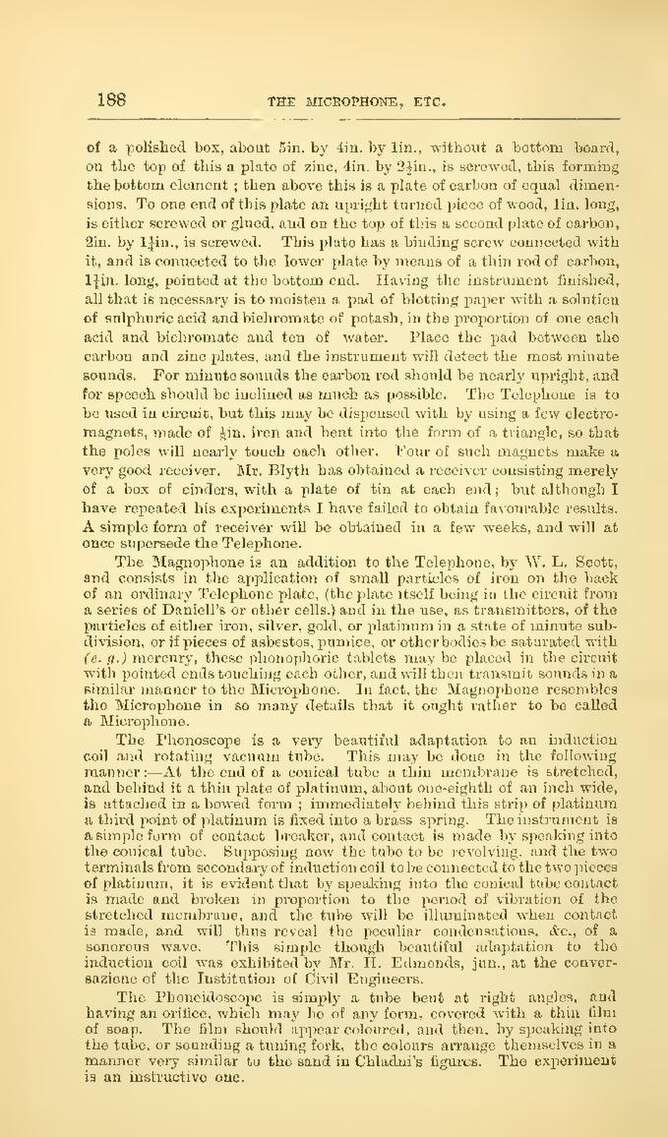of a polished box, about 5in. by 4in. by 1in., without a bottom board, on the top of this a plate of zinc, 4in. by 2½in., is screwed, this forming the bottom clement; then above this is a plate of carbon of equal dimensions, To one end of this plate an upright turned piece of woad, 1in. long, is either screwed or glued, and on the top of this a second plate of carbon, 2in. by 1¼in., is screwed. This plate has a binding screw connected with it, and is connected to the lower plate by means of a thin rod of carbon, l¼in. long, pointed at the bottom end. Having the instrument finished, all that is necessary is to moisten a pad of blotting paper with a solution of sulphuric acid and bichromate of potash, in the proportion of one each acid and bichromate and ten of water. Place the pad between the carbon and zinc plates, and the instrument will detect the most minute sounds, For minute sounds the carbon red should be nearly upright, and for speech should be inclined as ranch as possible. The Telephone is to be used in circuit, but this may be dispensed with by using a few electro-magnets, made of ⅛in. iron and bent into the form of a triangle, so that the poles will nearly touch each other. Four of such magnets make a very good receiver. Mr. Blyth bas obtained a receiver consisting merely of a box of cinders, with a plate of tin at each end; but although I have repeated his experiments I have failed to obtain favourable results. A simple form of receiver will be obtained in a few weeks, and will at once supersede the Telephone.
The Magnophone is an addition to the Telephone, by W. L. Scott, and consists in the application of small particles ef iron on the hack of an ordinary Telephone plate, (the plate itself being in the circuit from a series of Daniell's or other cells.) and in the use, as transmitters, of the particles of either iron, silver. gold, or platinum in a state of minute subdivision, or if pieces of asbestos, pumice, or other bodies be saturated with (e.g.) mercury, these phonophoric tablets may be placed in the circuit with painted coils touching each other, and will then transmit sounds in a similar manner to the Microphone. In fact, the Magnophone resembles the Microphone in so many details that it ought rather to be called a Microphone.
The Phonoscope is a very beautiful adaptation to an induction coil and rotating vacuum tube. This may be done in the following manner:—At the end of a conical tube a thin membrane is stretched, and behind if a thin plate of platinum, about one-eighth of an inch wide, is attached to a bowed form; immediately behind this strip of platinum a third point of platinum is fixed into a brass spring. The instrument is a simple form of contact breaker, and contact is made by speaking into the conical tube. Supposing now the tube to be revolving, and the two terminals from secondary of induction coil to be connected to the two pieces of platinum, it is evident that by speaking into the conical tube contact is made and broken in proportion to the period of vibration of the stretched membrane, and the tube will be illuminated when contact is made, and will thus reveal the peculiar condensations, &c., of a sonorous wave. This simple though beautiful adaptation to the induction coil was exhibited by Mr. H. Edmonds, jun., at the conversazione of the Institution of Civil Engineers.
The Phoneidoscope is simply a tube bent at right angles, and having an orifice, which may ho of any form. covered with a thin film of soap. The film should appear coloured, and then, by speaking into the tube, or sounding a tuning fork, the colours arrange themselves in a manner very similar to the sand in Chladni's figures. The experiment is an instructive one.
